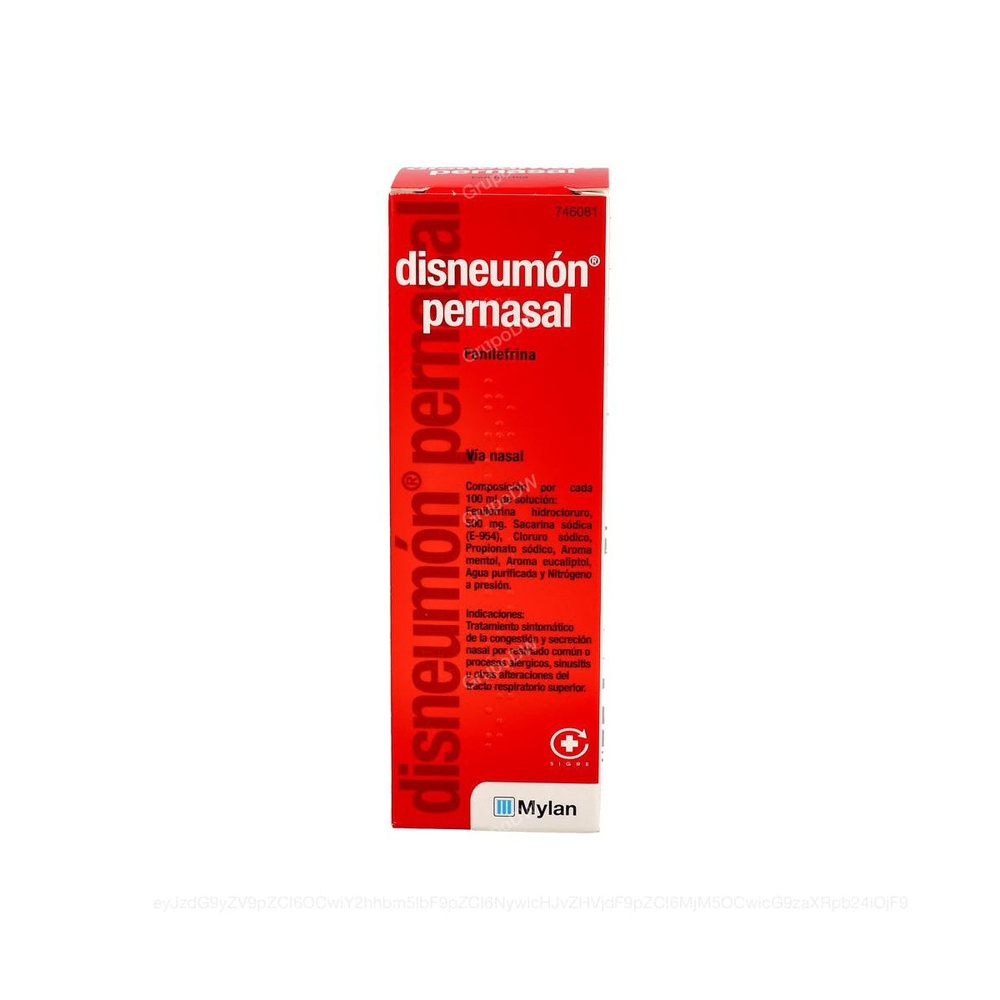

ДІСНЕУМОН ПЕРНАСАЛ 5 мг/мл РОЗЧИН ДЛЯ НАСАЛЬНИХ СПРЕЇВ

Запитайте лікаря про рецепт на ДІСНЕУМОН ПЕРНАСАЛ 5 мг/мл РОЗЧИН ДЛЯ НАСАЛЬНИХ СПРЕЇВ

Інструкція із застосування ДІСНЕУМОН ПЕРНАСАЛ 5 мг/мл РОЗЧИН ДЛЯ НАСАЛЬНИХ СПРЕЇВ
Введення
Опис: інформація для користувача
Disneumon перорально 5 мг/мл розчин для інгаляції в ніс
фенілефрин гідрохлорид
Прочитайте уважно весь опис перед початком використання цього лікарського засобу, оскільки він містить важливу інформацію для вас.
- Збережіть цей опис, оскільки вам може знадобитися знову його прочитати.
- Якщо у вас є якісь питання, проконсультуйтеся з вашим лікарем, фармацевтом або медсестрою.
- Цей лікарський засіб призначений лише вам, і не слід давати його іншим людям, навіть якщо вони мають相同ні симптоми, оскільки це може нашкодити їм.
- Якщо ви відчуваєте побічні ефекти, проконсультуйтеся з вашим лікарем, фармацевтом або медсестрою, навіть якщо це побічні ефекти, які не вказані в цьому описі. Див. розділ 4.
Зміст опису
- Що таке Disneumon перорально і для чого він використовується
- Що потрібно знати перед початком використання Disneumon перорально
- Як використовувати Disneumon перорально
- Можливі побічні ефекти
- Зберігання Disneumon перорально
- Зміст упаковки та додаткова інформація
1. Що таке Disneumon перорально і для чого він використовується
Активний інгредієнт Disneumon перорально - фенілефрин гідрохлорид; який належить до групи лікарських засобів, званих назальними деконгестантами.
Фенілефрин, введений назально, має інтенсивну, швидку і тривалу місцеву вазоконстриктивну дію, яка призводить до звільнення носових проходів.
Він показаний для симптоматичного лікування закладення носа та виділення з носа при звичайному застуді або алергічних процесах, синуситі чи інших порушеннях верхніх дихальних шляхів у дорослих і дітей старше 12 років.
Якщо симптоми тривають більше трьох днів або погіршуються, проконсультуйтеся з вашим лікарем.
Вам слід проконсультуватися з лікарем, якщо ваш стан погіршується або не покращується після 3 днів.
2. Що потрібно знати перед початком використання Disneumon перорально
Не використовуйте Disneumon перорально
- Якщо ви алергічні на фенілефрин або на якийсь інший компонент цього лікарського засобу (включно з розділом 6).
Якщо у вас є гіпертонія або периферична судинна хвороба (погана циркуляція), захворювання серця, цукровий діабет, гіпертиреоз, синдром Рейно чи гіпертрофія передміхурової залози.
Якщо ви приймаєте лікарські засоби для лікування депресії (інгібітори моноамінооксидази (МАО) або трициклічні антидепресанти).
Якщо вам нещодавно зробили операцію на голові (якщо ви зазнали якоїсь хірургічної операції на черепі, носі або роті)
Якщо у вас є захворювання очей з підвищенням внутрішньоочного тиску (глаукома з закритим кутом) або сухість слизової оболонки носа з утворенням кірок (сухий риніт).
Діти молодше 6 років не повинні використовувати цей лікарський засіб.
Попередження та застереження
Проконсультуйтеся з вашим лікарем, фармацевтом або медсестрою перед початком використання Disneumon перорально.
Проконсультуйтеся з вашим лікарем перед використанням цього лікарського засобу, якщо:
- у вас є високий рівень цукру в крові (цукровий діабет)
- у вас є гіпертонія
- Якщо ви страждаєте на захворювання серця, включаючи хронічні захворювання серця, порушення циркуляції, порушення ритму серця, тахікардію (швидку серцеву діяльність), брадикардію (повільну серцеву діяльність), блокаду серця, стенокардію;
- Якщо у вас є захворювання судин, chẳng hạn як атеросклероз (затвердіння та загустіння стінок судин);
- Якщо у вас є погана циркуляція крові в мозку;
- у вас є захворювання передміхурової залози з труднощами при сечовипусканні (гіпертрофія передміхурової залози)
- у вас є захворювання щитоподібної залози (гіпертиреоз)
- у вас є синдром Рейно
- ви приймаєте лікарські засоби для лікування депресії або астми (з групи "бронходилататорів").
- Якщо у вас є глаукома з закритим кутом (рідкісне захворювання очей).
У пацієнтів з важкою серцевою недостатністю фенілефрин може погіршити серцеву недостатність через звуження судин.
Ваш тиск буде контролюватися під час лікування. Якщо у вас є захворювання серця, буде проведено додатковий контроль над вашими життєво важливими функціями.
Не перевищуйте рекомендовану дозу.
Якщо у вас з'являється безсоння (дуже рідко), спробуйте уникати застосування лікарського засобу наприкінці дня або вночі.
Якщо симптоми тривають більше трьох днів або погіршуються, проконсультуйтеся з вашим лікарем.
Слід уникати надмірного або тривалого використання лікарського засобу (зазвичай менше 5 днів поспіль), оскільки це може призвести до закладення носа з підвищенням закладення та виділення з носа
Для уникнення інфекцій лікарський засіб не повинен використовуватися більш ніж однією людиною
Спортсменам повідомляється, що цей лікарський засіб містить компонент, який може призвести до позитивного результату допінг-контролю
Діти
Проконсультуйтеся з вашим лікарем щодо використання цього лікарського засобу в дітей віком від 6 до 12 років.
Не слід призначати дітям молодше 6 років.
Інші лікарські засоби та Disneumon перорально
Повідоміть вашого лікаря або фармацевта, якщо ви приймаєте, нещодавно приймали або можете приймати інші лікарські засоби.
Цей лікарський засіб не слід приймати разом з антидепресантами (інгібіторами моноамінооксидази - МАО - або трициклічними антидепресантами, оскільки це може призвести до серцево-судинних ефектів, таких як гіпертонія, через вазоконстриктивну дію фенілефрину.) або бронходилататорами, які використовуються для лікування астми.
Вагітність, лактація та фертильність
Якщо ви вагітні або перебуваєте в період лактації, вважаєте, що можете бути вагітною або плануєте завагітніти, проконсультуйтеся з вашим лікарем або фармацевтом перед використанням цього лікарського засобу. Цей лікарський засіб не слід використовувати під час вагітності.
Жінки в період лактації повинні проконсультуватися з лікарем перед використанням цього лікарського засобу.
Водіння транспортних засобів та використання машин
Не описані. Якщо ви відчуваєте сонливість або головокружіння, не водьте транспортні засоби та не використовуйте машини.
Disneumon перорально містить натрій
Цей лікарський засіб містить менше 23 мг натрію (1 ммоль) на мілілітр, тобто є "практично без натрію".
3. Як використовувати Disneumon перорально
Слідуйте точно інструкціям щодо застосування лікарського засобу, вказаним в цьому описі або вказаним вашим лікарем, фармацевтом або медсестрою. У разі сумнівів проконсультуйтеся з вашим лікарем, фармацевтом або медсестрою.
Дорослі та діти старше 12 років: 1 застосування в кожному носовому проході, яке можна повторити кожні 4-6 годин. Не слід скорочувати час між застосуванням та застосуванням.
У дітей віком від 6 до 12 років
рекомендується 1 застосування в кожному носовому проході кожні 6 годин.
Використання в дітей та підлітків
Діти віком від 6 до 12 років
Проконсультуйтеся з вашим лікарем щодо використання цього лікарського засобу в дітей віком від 6 до 12 років
Діти молодше 6 років
Не слід призначати дітям молодше 6 років.
Форма застосування
Назально.
Для правильного застосування цього лікарського засобу необхідно, щоб флакон та голова перебували в вертикальному положенні, як показано на малюнку, під час натискання пальцем на верхню частину дифузора. Кожен натиск повинен бути коротким, тобто тривати лише той час, який необхідний для натискання та відпускання.


У цей момент та одночасно необхідно зробити глибокий вдих, щоб полегшити максимальне проникнення лікарського засобу.
Якщо нахилити флакон або голову під час натискання, це може призвести до витікання пропульсуючого газу та зробити аерозоль непридатним для використання.
Слідуючи цим рекомендаціям, малоймовірно виникнення будь-яких ускладнень під час нормального використання лікарського засобу. Однак у деяких окремих випадках може виникнути механічна несправність клапана або дифузора, яка унеможливлює вилив ліків. Якщо це трапляється, лікарський засіб слід замінити на новий.
Якщо ви використовуєте більше Disneumon перорально, ніж потрібно
При високих дозах або випадковому прийомі можуть виникнути нежатковані ефекти, такі як головний біль, нервозність, безсоння, серцебиття, гіпертонія та розмитість зору.
У разі передозування або випадкового прийому проконсультуйтеся з вашим лікарем, фармацевтом або медсестрою або зверніться до Токсикологічної служби, телефон 91 562 04 20, вказавши лікарський засіб та кількість, прийняту.
Якщо ви забули використовувати Disneumon перорально
Не застосовуйте подвійну дозу для компенсації пропущених доз.
Якщо ви припиняєте лікування Disneumon перорально
Якщо у вас є якісь інші питання щодо використання цього лікарського засобу, проконсультуйтеся з вашим лікарем, фармацевтом або медсестрою.
4. Можливі побічні ефекти
Як і всі лікарські засоби, цей лікарський засіб може призвести до побічних ефектів, хоча не всі люди їх відчувають.
Часто трапляються головний біль, чхання, свербіж у носі, риніт, сухість або відчуття печіння в слизовій оболонці носа та залежність від лікарського засобу. Наступні побічні реакції є рідкісними, особливо при застосуванні високих доз, можуть виникнути вертіго, нервозність, тахікардія, головокружіння, нудота, блювота, нездужання, висипання на шкірі, гіпертонія та серцебиття, а також труднощі з засипанням.
Надмірне або тривале використання лікарського засобу може призвести до закладення носа з підвищенням закладення та виділення з носа, труднощами при сечовипусканні та затримкою сечі у пацієнтів з проблемами передміхурової залози.
Якщо ви спостерігаєте будь-яку іншу побічну реакцію, не описану вище, проконсультуйтеся з вашим лікарем або фармацевтом.
Надмірне або тривале використання лікарського засобу може призвести до закладення носа з підвищенням закладення та виділення з носа.
Якщо ви спостерігаєте будь-яку іншу побічну реакцію, не описану вище, проконсультуйтеся з вашим лікарем або фармацевтом.
Повідомлення про побічні ефекти
Якщо ви відчуваєте будь-який побічний ефект, проконсультуйтеся з вашим лікарем, фармацевтом або медсестрою, навіть якщо це можливі побічні ефекти, які не вказані в цьому описі. Ви також можете повідомити про них безпосередньо через Систему фармакологічного моніторингу лікарських засобів для людини: https://www.notificaram.es. Надсилаючи повідомлення про побічні ефекти, ви можете допомогти забезпечити більшу безпеку цього лікарського засобу.
5. Зберігання Disneumon перорально
Тримайте цей лікарський засіб поза досяжністю дітей.
Не використовуйте цей лікарський засіб після закінчення терміну придатності, вказаного на коробці після CAD або EXP. Термін придатності - останній день місяця, вказаного.
Балон під тиском не слід піддавати прямому сонячному світлу чи температурам вище 50 °C.
Не слід проколювати, ламати чи палити балон, навіть якщо він здається порожнім
Лікарські засоби не слід викидати у каналізацію чи сміття. Відкладайте балони та лікарські засоби, які вам не потрібні, у пункт збору SIGRE в аптеці. У разі сумнівів проконсультуйтеся з вашим фармацевтом щодо того, як позбутися балонів та лікарських засобів, які вам не потрібні. Таким чином, ви допоможете захистити довкілля.
6. Зміст упаковки та додаткова інформація
Склад Disneumon перорально
Активний інгредієнт - фенілефрин (у вигляді гідрохлориду). Кожен мілілітр розчину містить 5 мг активного інгредієнту.
- Інші компоненти (експіцієнти) - содій сакаринат (Е-954), хлорид натрію, пропіонат натрію, ментоловий аромат, евкаліптовий аромат, очищена вода та азот під тиском.
Вигляд продукту та вміст упаковки
Флакон з червоного скла з назальним аплікатором білого кольору об'ємом 25 мл розчину для інгаляції в ніс.
Уповноважений особи, яка отримала дозвіл на торгівлю
Cooper Consumer Health B.V.
Verrijn Stuartweg 60,
1112 AX Diemen,
Нідерланди
Відповідальна особа за виробництво
Recipharm Parets, S.L.
Ramón y Cajal, 2, 08150 Parets del Vallés (Барселона)
Іспанія
Для отримання додаткової інформації щодо цього лікарського засобу зверніться до місцевого представника уповноваженої особи, яка отримала дозвіл на торгівлю:
Vemedia Pharma Hispania, S.A.
C/ Aragón, 182, 5ª planta
08011 - Барселона
Іспанія
Дата останнього перегляду цього опису:квітень 2020
Детальна та актуальна інформація про цей лікарський засіб доступна на сайті Іспанського агентства з лікарських засобів та медичних продуктів (AEMPS) https://www.aemps.gob.es
- Країна реєстрації
- Діючі речовини
- Потрібен рецептНі
- Виробник
- Інформація є довідковою і не є медичною порадою. Перед прийомом будь-яких препаратів обов'язково проконсультуйтеся з лікарем. Oladoctor не несе відповідальності за медичні рішення, прийняті на основі цього контенту.
- Альтернативи до ДІСНЕУМОН ПЕРНАСАЛ 5 мг/мл РОЗЧИН ДЛЯ НАСАЛЬНИХ СПРЕЇВФорма випуску: ПРОДУКТ ДЛЯ НАСАЛЬНОГО ЗАСТОСУВАННЯ, 1 мгДіючі речовини: xylometazolineНе потрібен рецептФорма випуску: ПРОДУКТ ДЛЯ НАСАЛЬНОГО ЗАСТОСУВАННЯ, 0,5 мг/млДіючі речовини: oxymetazolineВиробник: Pharmex Advanced Laboratories S.L.Не потрібен рецептФорма випуску: ПРОДУКТ ДЛЯ НАСАЛЬНОГО ЗАСТОСУВАННЯ, Ксилометазоліну гідрохлорид 0,1%Діючі речовини: xylometazolineВиробник: Kern Pharma S.L.Не потрібен рецепт
Аналоги ДІСНЕУМОН ПЕРНАСАЛ 5 мг/мл РОЗЧИН ДЛЯ НАСАЛЬНИХ СПРЕЇВ в інших країнах
Найкращі аналоги з тією самою діючою речовиною та терапевтичним ефектом.
Аналог ДІСНЕУМОН ПЕРНАСАЛ 5 мг/мл РОЗЧИН ДЛЯ НАСАЛЬНИХ СПРЕЇВ у Україна
Лікарі онлайн щодо ДІСНЕУМОН ПЕРНАСАЛ 5 мг/мл РОЗЧИН ДЛЯ НАСАЛЬНИХ СПРЕЇВ
Консультація щодо дозування, побічних ефектів, взаємодій, протипоказань та поновлення рецепта на ДІСНЕУМОН ПЕРНАСАЛ 5 мг/мл РОЗЧИН ДЛЯ НАСАЛЬНИХ СПРЕЇВ – за рішенням лікаря та згідно з місцевими правилами.







